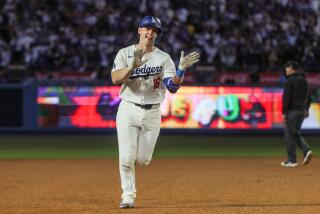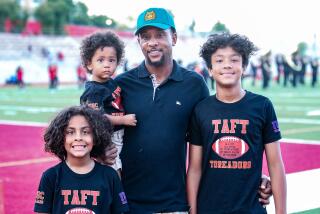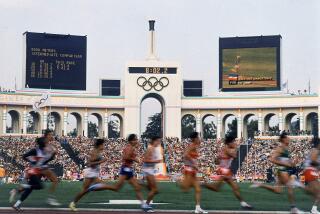Track Star Smith Ends His Running Odyssey : Bruin Great, Now Working on His Acting, Comes Back to UCLA to Coach
In 1978 and ‘79, John Smith, who had become the world’s best runner at 440 yards in 1971, found himself about as far from the limelight in track as he could possibly get: running in parimutuel races in Australia.
That’s right, parimutuel. Races in which people bet on people--not on horses or greyhounds.
At the time, Smith, 34, the former UCLA and international sprinter who still holds the world record (44.5) in the 440 (an event seldom run today) and was a member of the U. S. team in the 1972 Olympics in Munich, was an outcast from the world of amateur track and field.
Barred from running as an amateur because he had been a professional both in track and in football, he was doing what he did best wherever he could. That meant Australia, where people apparently bet on men as fervidly as they do on horses.
Handicapped Runner
Smith, in his first year as a UCLA assistant track coach while he also pursues an acting career, didn’t win many races in Australia; he wasn’t supposed to. The events were handicap races, and Smith, as one of the world’s best runners, usually ran from scratch while others in the field got head starts on him in dashes from 100 to 400 meters.
You might think that he would have found his Australian experience to be demeaning, that he felt about as optimistic in his situation as the exhausted and depressed marathon dancers in the novel and film “They Shoot Horses, Don’t They?”
Not Smith. Though he said he won only two or three races in two years and failed to get the lion’s share of purses that ran as high as $15,000, he said he enjoyed himself.
“At least I was running,” he said in an interview before a practice at UCLA’s Drake Stadium. “I wasn’t making big money, but I lived very well--and I was doing what I wanted to do.”
Before he went to Australia, he said, the Amateur Athletic Union and the International Amateur Athletic Federation (IAAF) had taken away his amateur status in track. He was barred from running as an amateur because he had spent two years as a member of (but not a regular wide receiver for) the Dallas Cowboys of the National Football League and because he later ran professionally as a member of the International Track Assn. (ITA), which operated for a few years and then folded.
‘Famous but Broke’
After his stints in pro football and track, he said, “I was famous but broke. I was the best in the world (at running the quarter-mile), but I was without a forum to display it. Talk about a living hell, I was trapped in my own profession.”
He said he left Australia--where his running companion was former UCLA star sprinter Warren Edmonson--because he was in that country on a temporary visa as an athlete and he was getting the feeling that his running for money was “taking work away from residents.”
Back in the U. S., he decided “to get my amateur status back.” He said he became a spokesman in that cause for other former ITA athletes before The Athletic Congress (a new organization that had taken over governing U .S. track from the AAU) and the IAAF.
He said he regained his amateur status and was hoping to run in the 1980 Olympics and win a gold medal, a chance he was deprived of in Munich in 1972 when he pulled up lame in the 400-meter finals.
Swift at Long Beach
He showed he hadn’t lost anything in his first 400-meter race in January, 1980, at the Long Beach Arena. He said it was his first indoor effort since 1976 and that he ran a 47.2, “one of the fastest times that year.”
He didn’t get to the 1980 Olympics, not just because of the U. S. boycott of the Moscow Games but because he had injured himself in a race at Madison Square Garden. He bruised a heel bone and twice underwent surgery for a ruptured Achilles’ tendon, spending most of the next three years in rehabilitation.
“The pain was so bad that I couldn’t get out of bed at times. At times, I could feel my heartbeat in my heel.”
During periods of inactivity in track, he had worked at various jobs--as a model, acting and doing voice-overs in television commercials, lecturing to youth in the U. S., Canada and the Dominican Republic on the Olympics and self-development and as a sales representative for a manufacturer of postage machines.
Track Was ‘Best Friend’
But until 1983, he said, he had never faced the possibility of giving up running. He did after his second operation.
“Track and field was my best friend,” he said, adding that the thought of stopping made him cry. “It got me out of trouble,” he said, taking him to stardom at Fremont High School and UCLA and away from the sometimes desperate streets of South-Central Los Angeles.
As a 19-year-old UCLA sophomore, Smith had failed to make the 440 finals in the 1970 NCAA championships, but he did get into the 440 in the national AAU championships that year--because they needed eight men to round out the field.
Smith had the slowest time in the AAU field, but he startled the track world by coming from behind to nip Olympic champion Lee Evans for first and beat some other world-class quarter-milers. Both Smith and Evans, who set a world record of 43.86 for 400 meters in the 1968 Olympics in Mexico City, were timed in 45.7.
Rather shy and taciturn before that race, Smith came out of his shell afterward. “The year before that I was working the summer at Bethlehem Steel, and the next year I was a superstar, beating my idols. That forced me to learn how to speak (in public).
‘Didn’t Want’ Fame
“I really didn’t want it (the fame); before that I was secure and safe. After, it was ‘Beg your pardon, Mr. Smith’ and no ‘boy’ or ‘hey you.’ Instead of a follower, I was a trend setter.”
When he had recovered from his heel operations, he said he decided “to put track behind me and concentrate on my acting.” And he did, but he went out with a bang, running a 46.8 in an invitational 400 at last spring’s UCLA-Texas meet.
He said he accepted an offer from Bob Larsen, in his first year as UCLA head track coach, to coach Bruin sprinters, only after he had been assured that he would have the flexibility to go to auditions or acting jobs when he had to.
Smith, who had also managed to squeeze in some coaching between his various jobs before becoming to UCLA as an assistant, takes his coaching seriously. He said he tries to be an “objective mirror” to Bruin sprinters, to be sensitive to problems they have with fatigue, classes and the struggle to excel.
He said he wants to help Larsen develop a track dynasty at UCLA and perhaps coach a prospect (maybe Hawthorne High School top sprinter Henry Thomas, who is going to UCLA) who can win the Olympic gold medal that Smith was prevented from winning by his injury in 1972 at Munich. “That will be my medal,” he said.
Writing and Acting
His first published article (written with David Groves and on the topic of the alliance between a coach and an athlete) is out in the May issue of Sports Fitness magazine. And he wants to do more writing, perhaps a book on his track career.
In his acting career, he has had guest roles in a couple of television series, appeared in a stage productions, had a walk-on part in the movie “Personal Best” and has made two other movies. One film, “Sunset Strip,” will soon be released.
He is not satisfied with the little acting he has done and wants to do more. But he added: “I’m not a starving actor, I’m hungry.”
More to Read
Go beyond the scoreboard
Get the latest on L.A.'s teams in the daily Sports Report newsletter.
You may occasionally receive promotional content from the Los Angeles Times.









